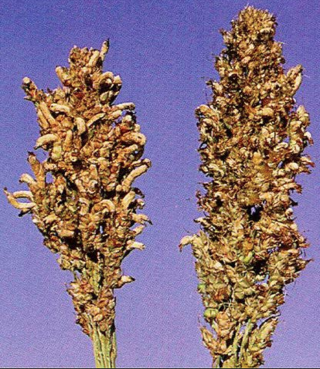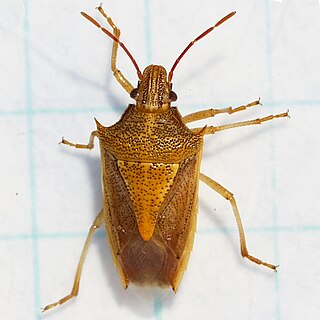
Millets are a highly varied group of small-seeded grasses, widely grown around the world as cereal crops or grains for fodder and human food. Most species generally referred to as millets belong to the tribe Paniceae.

Sorghum or broomcorn is a genus of about 25 species of flowering plants in the grass family (Poaceae). Sorghum bicolor is grown as a cereals for human consumption and as animal fodder.

Sweet sorghum or sorgo is any of the many varieties of the sorghum grass whose stalks have a high sugar content. Sweet sorghum thrives better under drier and warmer conditions than many other crops and is grown primarily for forage, silage, and syrup production.

Pearl millet is the most widely grown type of millet. It has been grown in Africa and the Indian subcontinent since prehistoric times. The center of diversity, and suggested area of domestication, for the crop is in the Sahel zone of West Africa. Recent archaeobotanical research has confirmed the presence of domesticated pearl millet on the Sahel zone of northern Mali between 2500 and 2000 BC. 2023 was the International Year of Millets, declared by the United Nations General Assembly in 2021.

Sorghum × drummondii, is a hybrid-derived species of grass raised for forage and grain, native to tropical and subtropical regions of Eastern Africa. It may also be known as Sorghum bicolor × Sorghum arundinaceum after its parents. Some authorities consider all three species to be subspecies under S. bicolor.

Striga, commonly known as witchweed, is a genus of parasitic plants that occur naturally in parts of Africa, Asia, and Australia. It is currently classified in the family Orobanchaceae, although older classifications place it in the Scrophulariaceae. Some species are serious pathogens of cereal crops, with the greatest effects being in savanna agriculture in Africa. It also causes considerable crop losses in other regions, including other tropical and subtropical crops in its native range and in the Americas. The generic name derives from Latin strī̆ga, "witch".

Johnson grass or Johnsongrass, Sorghum halepense, is a plant in the grass family, Poaceae, native to Asia and northern Africa. The plant has been introduced to all continents except Antarctica, and most larger islands and archipelagos. It reproduces by rhizomes and seeds.

Sorghum bicolor, commonly called sorghum and also known as great millet, broomcorn, guinea corn, durra, imphee, jowar, or milo, is a species in the grass genus Sorghum cultivated for its grain. The grain is used for food for humans; the plant is used for animal feed and ethanol production. Sorghum originated in Africa, and is now cultivated widely in tropical and subtropical regions.

Claviceps sorghi is a fungal plant pathogen belonging to the phylum Ascomycota in the kingdom Fungi- its anamorphic phase is known as sphacelia sorghi. This species was first found in In India in 1915 and officially recorded in 1948 . The Claviceps genus is known for their infection of cereal and millet crops. This particular species of Claviceps infects Sorghum- giving the fungus its name 'sorghi'. These species in Claviceps are known to produce ergot on their host, as a byproduct of their infection. This can cause the disease known as ergotism when the infected crop is consumed.
Sporisorium sorghi, commonly known as sorghum smut, is a plant pathogen that belongs to the Ustilaginaceae family. This fungus is the causative agent of covered kernel smut disease and infects sorghum plants all around the world such as Sorghum bicolor (sorghum), S. sudanense, S. halepense and Sorghumvulgare var. technichum (broomcorn). Ineffective control of S. sorghi can have serious economic and ecological implications.

Ascochyta sorghi is a fungal plant pathogen. It causes Ascochyta leaf spot on barley that can also be caused by the related fungi Ascochyta hordei, Ascochyta graminea and Ascochyta tritici. It is considered a minor disease of barley.
The Sesotho language has traditional names for the months of the familiar Gregorian calendar. The names reflect a deep connection that the Basotho people traditionally have with the natural world and the importance of agriculture.
An arrowhead is the point of an arrow.
S. nigra is an abbreviation of a species name. In binomial nomenclature the name of a species is always the name of the genus to which the species belongs, followed by the species name. In S. nigra the genus name has been abbreviated to S. and the species has been spelled out in full. In a document that uses this abbreviation it should always be clear from the context which genus name has been abbreviated.
Prunicolor, a Latin word meaning plum-coloured, may refer to:
S. nigrum is an abbreviation of a species name. In binomial nomenclature the name of a species is always the name of the genus to which the species belongs, followed by the species name. In S. nigrum the genus name has been abbreviated to S. and the species has been spelled out in full. In a document that uses this abbreviation it should always be clear from the context which genus name has been abbreviated.
S. niger is an abbreviation of a species name. In binomial nomenclature, the name of a species is always the name of the genus to which the species belongs, followed by the species name. In S. niger, the genus name has been abbreviated to S. and the species has been spelled out in full. In a document that uses this abbreviation, it should always be clear from the context which genus name has been abbreviated.

Oebalus pugnax, the rice stink bug, is a flying insect in the shield bug family Pentatomidae native to North America that has become a major agricultural pest in the Southern United States. It has been a known pest since at least the time of Johan Christian Fabricius, who described the species in 1775.

Rivellia is a genus of signal flies. There are at least 140 described species in Rivellia.










